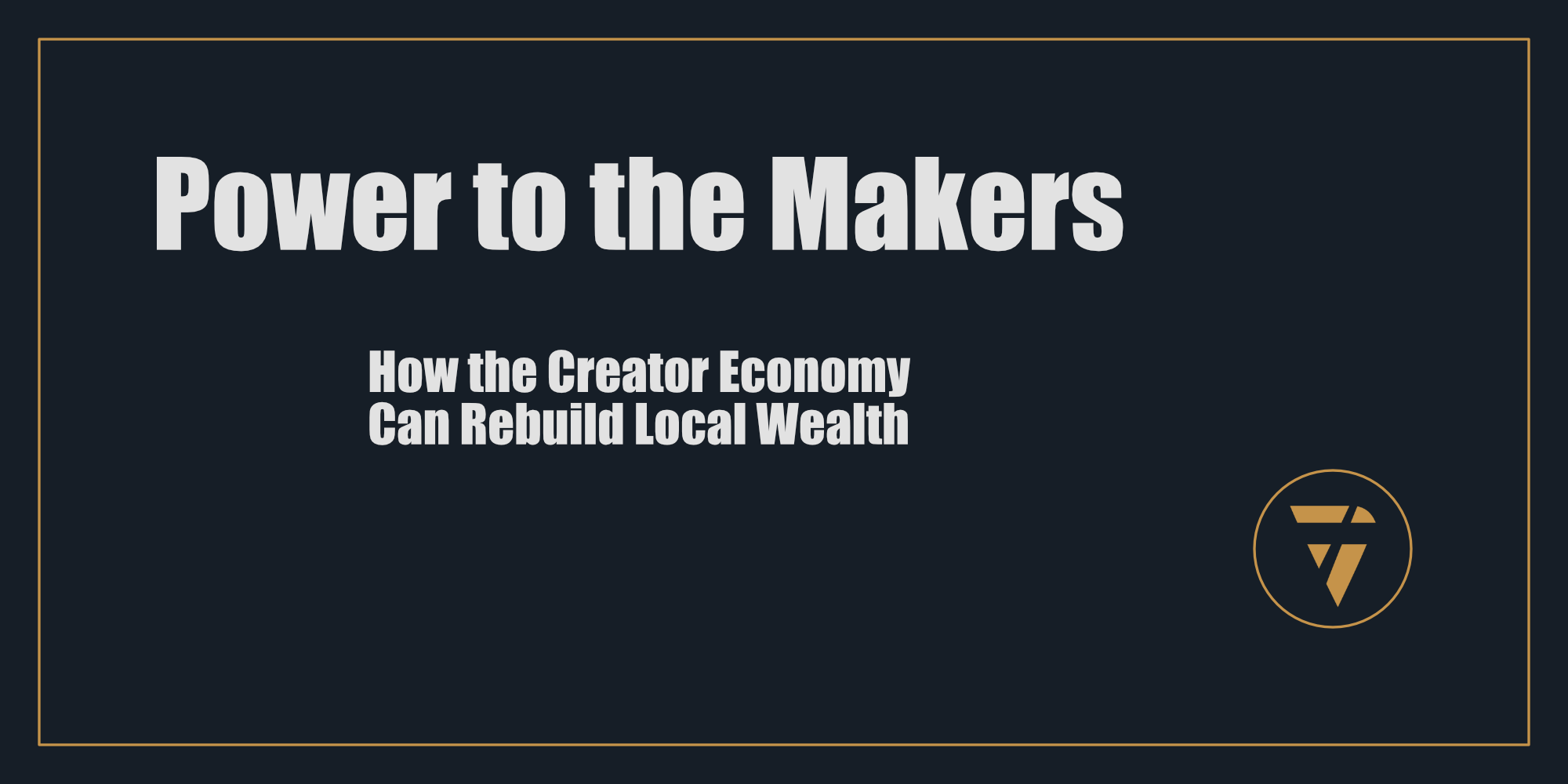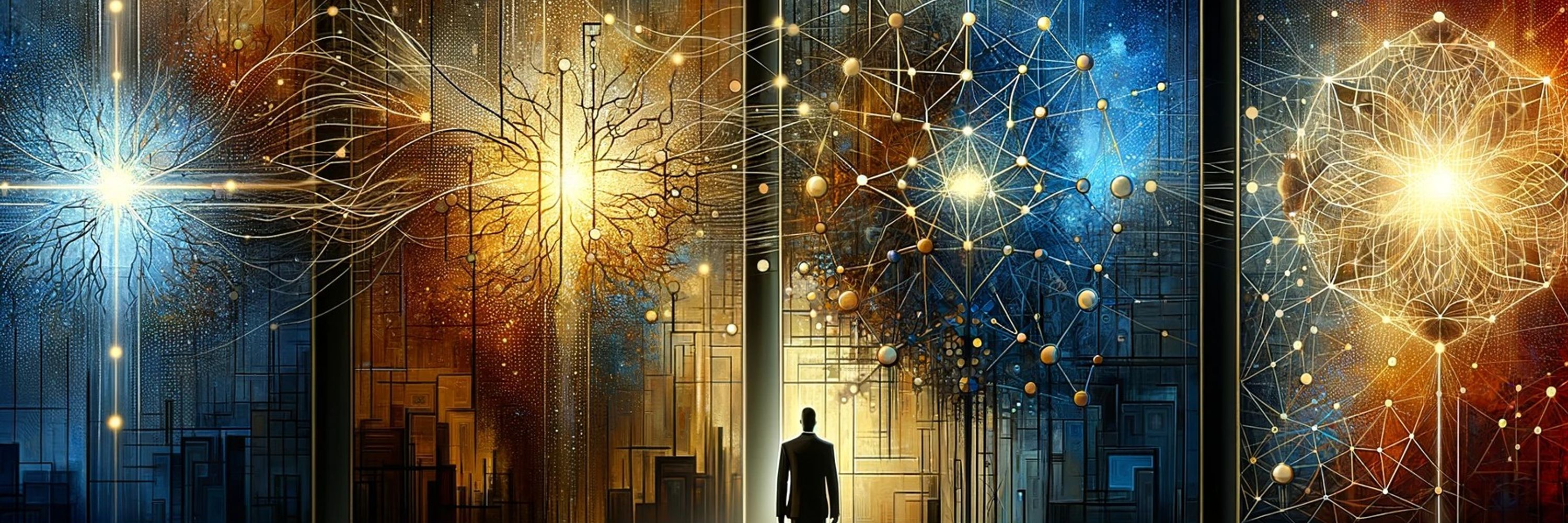Power to the Makers

How the Creator Economy Can Rebuild Local Wealth
For centuries, economic power was concentrated in the hands of the few—landowners, industrialists, corporate executives. Wealth flowed in one direction, from workers and consumers to institutions that dictated the terms of commerce.
The internet was supposed to change that. It promised a future where individuals could break free from corporate control, where small businesses could thrive, and where wealth could be generated without reliance on traditional employers. In many ways, it delivered: today, more people than ever make a living as independent creators, selling their knowledge, products, and art directly to audiences around the world.
Yet the story isn’t that simple. The creator economy, while full of potential, has been quietly captured by digital landlords—platforms that extract value while leaving creators to fight for scraps.
- YouTube takes a cut of every ad dollar.
- Instagram and TikTok control reach and distribution.
- Amazon undercuts independent sellers with its own competing products.
- Spotify owns everything.
The problem isn’t that creators aren’t producing wealth—it’s that they don’t own the infrastructure they rely on.
For the creator economy to truly rebuild local wealth, it must break free from digital monopolies and reclaim ownership of its economic future. This isn’t just about individual success, it’s about transforming the economy from the ground up.
The Myth of Platform Independence
Creators are often told they are their own bosses. The reality is more complex. While the internet allows anyone to start a business, the most valuable online real estate is owned by a handful of corporations.
These platforms operate like feudal lords:
- They set the rules—algorithm changes can wipe out an income overnight.
- They leave you a percentage—whether through ad revenue splits, transaction fees, or pay-to-play exposure, you get what they give you.
- They extract data—using creators’ insights and audience relationships to build their own products.
A writer on Substack, a musician on Spotify, or a filmmaker on YouTube is still ultimately dependent on someone else’s infrastructure. They are not independent in the way true ownership would allow.
The real opportunity lies not in maximizing income on these platforms, but in using them as tools to build self-sustaining systems that operate outside of them.
The Creator Economy as an Engine of Local Wealth
Most economic development strategies focus on attracting outside investment, building infrastructure, or subsidizing large businesses. Few focus on empowering local creators, makers, and entrepreneurs to generate and keep wealth within their own communities.
A thriving creator economy doesn’t just mean influencers selling courses or artists minting NFTs. It means:
- Craftsmen and artisans running online storefronts that serve their region.
- Local journalists building independent media free from corporate control.
- Musicians and filmmakers retaining full ownership of their work.
- Educators and consultants creating knowledge-based businesses that reinvest in their communities.
This is not just about digital success—it's about creating a decentralized, resilient economic foundation that does not rely on multinational corporations or external investors to sustain itself.
How the Creator Economy Can Rebuild Local Wealth
The key to making the creator economy work for local communities rather than just for tech platforms lies in five core strategies:
1. Direct Monetization Over Platform Dependence
Every creator must own their audience and revenue streams. This means moving beyond algorithm-driven visibility and building direct relationships through:
- Email lists and memberships—a personal audience is immune to algorithm changes.
- Community-owned marketplaces—instead of relying on Amazon, Etsy, or Shopify, local collectives can create their own sales platforms.
- Subscription-based funding—from Patreon to community-supported media, direct funding models are more stable than ad-based revenue.
The more direct the relationship between creator and customer, the more resilient the business.
2. Local Production and Digital Distribution
Not everything in the creator economy is digital. Local wealth grows when online creativity fuels real-world business.
- Independent publishers printing books locally instead of using Amazon’s services.
- Artists selling directly through community-driven marketplaces rather than mass-produced retail.
- Micro-manufacturing for creator-led product lines, keeping production and jobs local.
The intersection of local production and global distribution is where small creators can reclaim power.
3. Collective Ownership of Digital Infrastructure
Creators don’t just need platforms—they need to own them. If media, e-commerce, and content platforms were owned by the people who use them, they could be optimized for sustainability rather than extractive profit models.
Examples of collective infrastructure include:
- Co-operatively owned social networks that share profits with users.
- Decentralized payment systems that don’t take massive fees.
- Locally hosted content networks that eliminate reliance on tech giants.
If creators control their tools, they are no longer at the mercy of corporations that can deplatform, demonetize, or extract wealth without contribution.
4. Reshaping Education for Digital Independence
Most education systems still train workers for corporate jobs. They do not teach people how to create, market, or monetize their skills independently.
A shift in education could focus on:
- Teaching entrepreneurship from an early age, focusing on creator-led business models.
- Providing digital literacy training so creators understand how to protect their work.
- Building mentorship networks between experienced and emerging creators.
If the future of work is independent, education must reflect that.
5. Reinventing Local Investment
Venture capital backs scalable businesses that offer high returns, which often excludes creator-led businesses that focus on community wealth rather than rapid expansion.
New investment models could include:
- Community-backed investment funds for creator businesses.
- Local peer-to-peer lending networks.
- Crowdfunded property ownership to create sustainable workspaces.
When funding stays local, wealth does too.
The Future of Economic Development is Creator-Led
Traditional businesses chase efficiency, reducing costs and increasing automation. The creator economy is different, it's built on human creativity and direct relationships.
This means that it's resilient to economic shocks, because its foundation is not speculative finance or outsourced labour, but individual and collective skill, trust, and community engagement.
Rebuilding local wealth will not come from waiting for corporations to reinvest. It will come from empowering people to create, own, and sustain their own economic ecosystems.
Will the creator economy be owned by creators, or will they continue working inside systems built to extract wealth from them?
Power belongs to those who build the infrastructure, set the rules, and own the platforms. If creators reclaim ownership, they will change their own financial futures, and reshape the entire economic structure in the process.
This is what I’m working on. Tell me what you think, I enjoy the conversation! Subscribe and follow the work in real time.
Thanks!
B

Creators generate wealth, but who owns it? The future isn’t in chasing platform payouts, it’s in direct ownership, local production, and community-driven investment.
The creator economy isn’t just content, it’s economic power.
Take it back.
PS -






